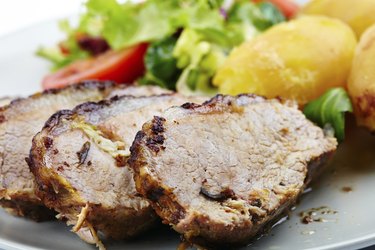
Pork loin, unlike a ham or less expensive roast cuts, contains little fat and cooks quickly due to its compact size and leanness. Because of its quick cooking and versatile flavor, pork loin works equally well for a busy weeknight dinner as for an elaborate holiday spread.
Cook Pork Tenderloin to 145 F
Video of the Day
According to the USDA, pork tenderloin must be cooked to a minimum internal temperature of 145 degrees Fahrenheit. After cooking, remove the meat from the heat and rest it for at least 3 minutes, which raises its temperature a bit more. Cooking the tenderloin to this temperature ensures its safety, while preserving its tenderness and juiciness. The meat may still have a pink tint in the middle when it's sliced. In the past, cooks recommended cooking pork until it became white and opaque throughout. This can dry out a lean cut like pork tenderloin.
Video of the Day
Store fresh pork tenderloin for 3 to 5 days in the refrigerator or in the freezer for 4 to 6 months.
20 Minutes Per Pound on the Grill
Grilling pork tenderloin on a preheated gas or charcoal grill sears and caramelizes the outside, locking in its sweet flavor. Preheat the grill to medium-hot and season the pork tenderloin, allowing it to rest at room temperature for up to 30 minutes before grilling. Place the pork tenderloin directly on the preheated grill grate and cover. Sear the tenderloin on all sides for 2 to 3 minutes each, or until it is browned on the outside. Remove the tenderloin from the hottest part of the grill and allow it to cook with the grill covered for 20 minutes per pound, or until the internal temperature registers 145 F.
Up to 25 Minutes Per Pound in the Oven
Roasting the pork tenderloin most likely results in a juicy and flavorful roast when started with a quick pan sear. Preheat the oven to 450 F. Heat a shallow skillet over high heat and add a drizzle of fat such as olive oil or butter. Sear the pork tenderloin in the hot skillet for a minute or two per side or until lightly browned. Transfer the meat to a shallow baking dish and place immediately in the preheated oven. Cook for an additional 20 to 25 minutes per pound or until the internal temperature registers 145 F when measured with a meat thermometer.
Up to 27 Minutes Per Pound on the Stove
In general, cooking the pork tenderloin over high heat for about 20 to 27 minutes per pound brings it to the required 145 F while preserving its inner juiciness. Whether pan-cooking the tenderloin on a stovetop, broiling it in an oven or cooking it on an indoor electric grill, the technique remains the same. Resist turning the tenderloin frequently, instead, keep it covered to ensure even heating throughout. Even in an open skillet, turn the pork tenderloin only enough to brown each side, then turn it once during cooking.
Brine to Keep It Juicy
Because pork tenderloin contains so little fat as compared to other cuts of pork and other meats, some companies may process it with a brining solution to enhance its juiciness. Because those brines contain artificial ingredients and flavorings, look instead for pork that isn't enhanced this way and brine it at home. Brining solutions contain a simple mix of ingredients, including: Water (use several cups, or enough to cover the tenderloin) Salt (add at least one cup of salt for every 3 cups of water) Sugar (any form of sugar works. Use 1/2 cup for every 3 cups of water) Seasonings
Soak the tenderloin in the brine, in the refrigerator, for up to 2 hours. Then, rinse the brine from the meat and pat it dry before seasoning and cooking. The brine uses the chemical process of osmosis to infuse the meat's cells with water that it retains even during cooking.